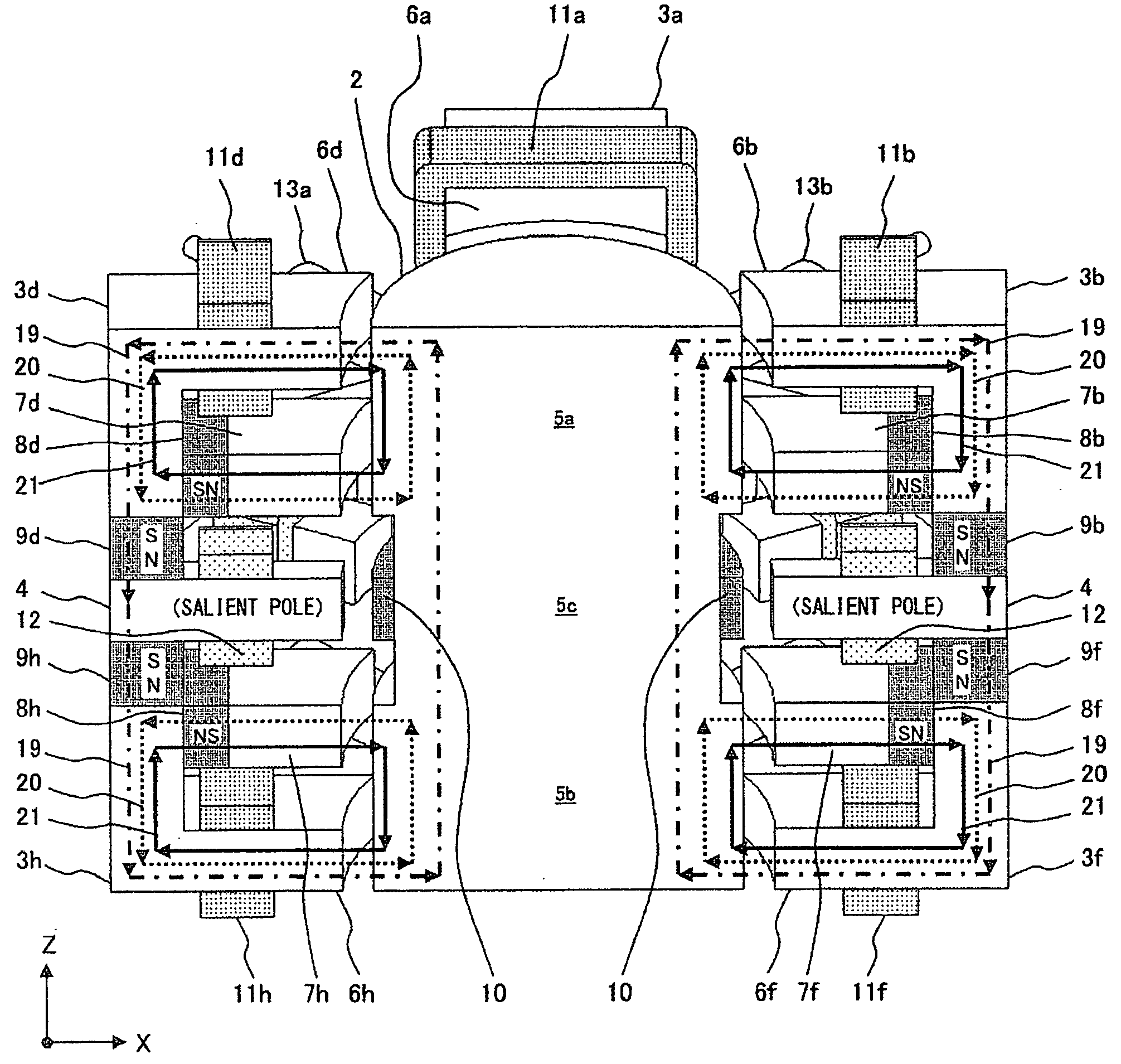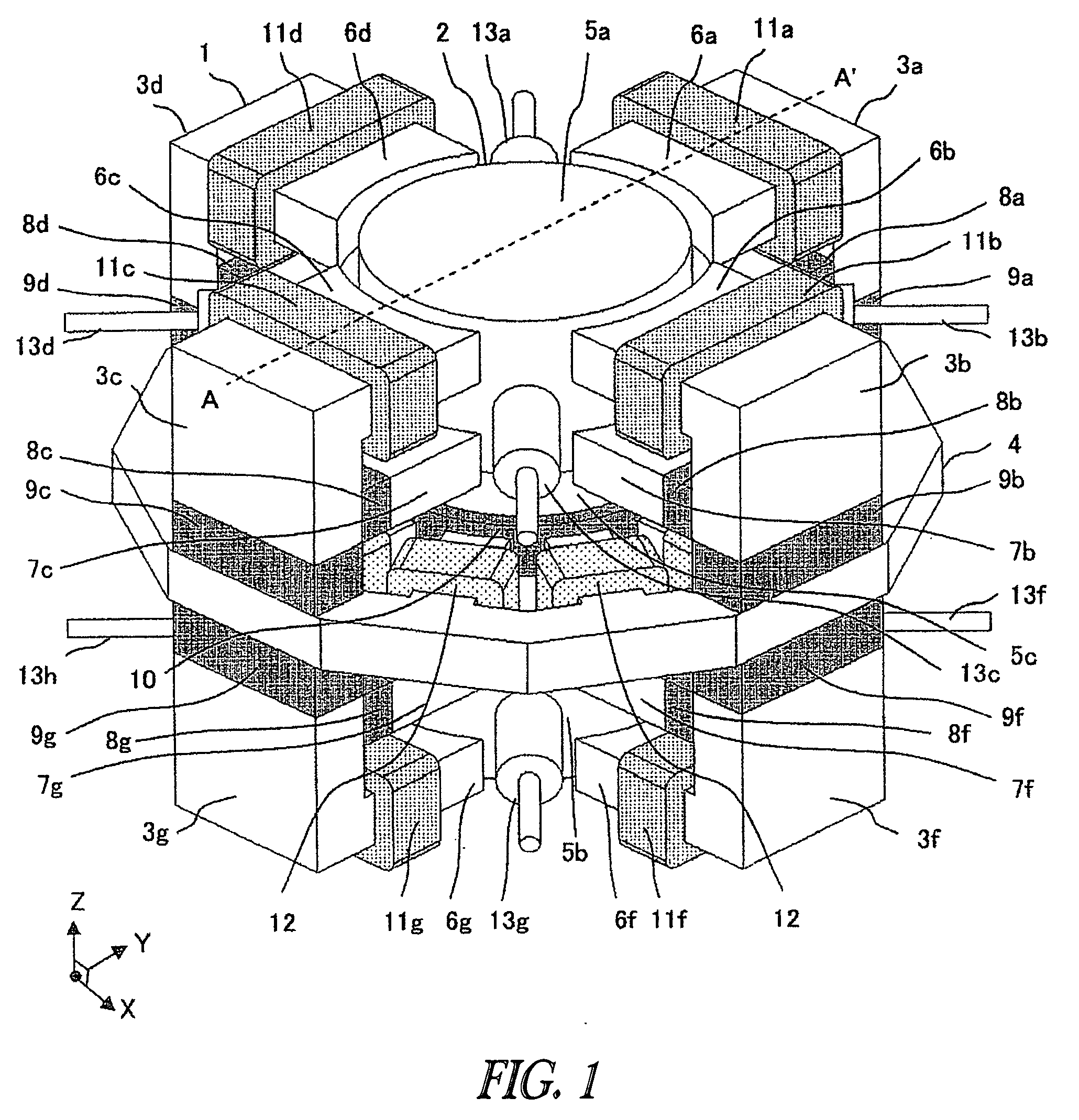Magnetic levitation motor and pump
a magnetic levitation and pump technology, applied in the direction of liquid fuel engines, machines/engines, magnetic bearings, etc., can solve the problems of large loss in sucking and discharging, difficult assembly, complicated configuration of the inlet and outlet of the pump, etc., and achieve the effect of reducing the loss of rotation of the rotor
- Summary
- Abstract
- Description
- Claims
- Application Information
AI Technical Summary
Benefits of technology
Problems solved by technology
Method used
Image
Examples
configuration example 1
[0051]As configuration example 1, FIG. 2 shows a configuration in which the polarities on the rotor's side in the first permanent magnets 8 (8a through 8d) and the polarities on the rotor's side in the first permanent magnets 8 (8e through 8h) are opposite. This figure is a perspective-cross-sectional view along the line A-A′ of the direction of the flux line.
[0052]The second salient poles 7 are arranged on the side of the motor yoke 4, and the first salient poles 6 are arranged on the side of the ends of the rotor 2. However, the first salient poles 6 can be arranged on the side of the motor yoke 4, and the second salient poles 7 can be arranged on the side of the ends of the rotor 2.
[0053]As shown in FIG. 2, each of the bias magnetic fluxes 20 of the first permanent magnets 8 forms a magnetic path “-first permanent magnet 8-second salient pole 7-rotor yoke 5-first salient pole 6-”. Each of the magnetic fluxes 19 of the second permanent magnets 9 forms a magnetic...
configuration example 2
[0061]As configuration example 2, FIG. 3 shows a configuration in which the polarities on the rotor's side in the first permanent, magnets 8 (8a through 8d) and the polarities on the rotor's side in the first permanent magnets 8 (8e through 8h) are the same. This figure is a perspective-cross-sectional view along the line A-A′ of the direction of the flux line.
[0062]In configuration 2, the polarity on the rotor's side in the first permanent magnets 8 and the polarity on the motor yoke 4 side in the second permanent magnets 9 are both north pole. However, the polarity on the rotor's side in the first permanent magnets 8 and the polarity on the motor yoke 4 side in the second permanent magnets 9 may both be the south pole.
[0063]The second salient poles 7 are arranged on the side of the motor yoke 4 and the first salient poles 6 are arranged on sides of both ends of the rotor 2; however, the first salient poles 6 may be arranged on the side of the motor yoke 4, and t...
example 1
VARIATION EXAMPLE 1
[0085]FIG. 6 shows a first variation example for the above example 1. The leakage of the magnetic flux from magnetic circuits that are not in the gaps between the magnetic bearing unit and the rotor 2 is taken into consideration, and the configuration is changed as described below in order to increase the performance of the magnetic suspension.
[0086]Each of the first permanent magnets 8 is divided, and permanent magnets are arranged on the surfaces facing the rotor 2 in the respective first salient poles 6 (6a through 6h) and the second salient poles 7 (7a through 7h) and at the roots of the second salient poles 7 (7a through 7h). In FIG. 6, the first permanent magnets 8 (8i through 8p) are arranged on the first salient poles 6 (6a through 6h). Also, the first permanent magnets 8 (8a through 8h and 8q through 8x) are arranged on the second salient poles 7 (7a through 7h).
[0087]The plurality of the first permanent magnets 8 may be arranged at any position on the sa...
PUM
 Login to View More
Login to View More Abstract
Description
Claims
Application Information
 Login to View More
Login to View More - R&D
- Intellectual Property
- Life Sciences
- Materials
- Tech Scout
- Unparalleled Data Quality
- Higher Quality Content
- 60% Fewer Hallucinations
Browse by: Latest US Patents, China's latest patents, Technical Efficacy Thesaurus, Application Domain, Technology Topic, Popular Technical Reports.
© 2025 PatSnap. All rights reserved.Legal|Privacy policy|Modern Slavery Act Transparency Statement|Sitemap|About US| Contact US: help@patsnap.com



